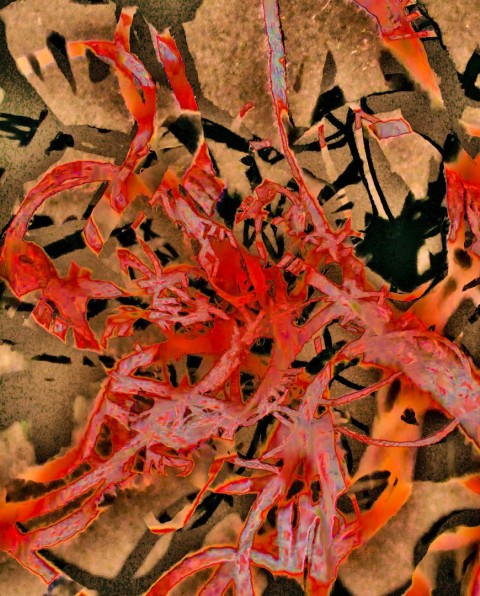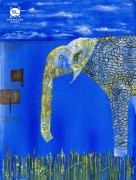When the eminent photojournalist and I were children, our school librarian had a seizure while reading aloud from a book of fairy tales. We were in the midst of Hansel and Gretel which, like every tale in the book, was a story of fierce morality, of cautions declawed to suit the sensibilities of the time. The characters never found themselves beheaded or folded into baking ovens or disfigured by cruel magic—these gruesome turns had been excised from the narratives—but each was accompanied by hideous illustrations that left me unsettled, fearful. The librarian displayed each with pride, as if she’d rendered them herself, and with us in mind.
Just before the seizure began, she displayed a particularly awful one, and I recall feeling revulsion for the alien figures on the page. Heads too large, eyes over-expressive, bodies lacking the proper architecture. I remember the eminent photojournalist—or the boy who would become him—fingering his shoelace: an excuse, I’d assumed, to avert his eyes.
I didn’t have the word then, but it was the depravity of those images that disturbed me. It seemed that such deviance tendered a glimpse not into another world, but into the bizarre internality of the commonplace. Below the skin, writhing things are impatient to erupt. I remember those illustrations because they brought me my first inkling of this notion: that tranquility can rupture into violence without advance notice. I could not have been the only one to carry this truth into adulthood.
The young photojournalist and I were not friends. We were both quiet, but his reticence to speak was not due to a fear of being made a fool of by our classmates, like mine was. I take his reaction to the librarian’s seizure as proof of this. He saw the world differently than most, and he possessed a steady curiosity that later in life permitted him to travel wherever his gaze was needed. Places no amount of money or fame could ever entice me to go.
It happened in the final minutes of the reading period. First the librarian’s eyes bulged. Then she lowered herself meekly to the floor as the book slipped from her fingers. Our classmates screamed and the librarian’s assistant, who I assume had been shelving books, threw open the door of the reading room. To her credit, she calmly shepherded the class out until only the photojournalist and I remained. He sat on the floor and watched her, and I watched him. He never lifted a hand to his face, never blinked. We would have sat there until it was over, but the librarian’s assistant returned, took us by our hands, and led us from the room. We were so young, I can assume he hadn’t yet discovered photography, but the man he became would have been snapping away furiously, preserving image after image of the librarian prone on the floor as her eyes rolled and her teeth clacked, and her fists pounded the rug.
I followed the photojournalist’s rise to prominence rather closely, so I was not surprised to hear his voice on the radio following the candidate’s assassination, which took place not far from where we’d grown up. He had been standing in the atrium of the statehouse as bullets whizzed around him, and he captured it all: the final moments of the candidate’s life, the assassin holding a hand aloft as if reaching for a rescue line, the blood already pooling near his feet. Weeks later, an interviewer asked the photojournalist what it had felt like: to watch a man die so violently, to feel the mechanism of history splutter and jerk forward. He said he didn’t know how it felt, because he wasn’t feeling anything at the time. He was on assignment, and the tragic turn of events hadn’t changed that—he had a job to do and he did it.
*
I bumped into him once at a restaurant on the east side of the city. I still lived there, and perhaps he was visiting family. He came through the door while my partner and I were retrieving our coats. I lifted my hand to greet him but stopped when, all at once, the diners and staff recognized him and broke into applause. People everywhere knew his photographs, but only here did people know his face. I hurried out the door but stood for a moment and watched him wave at the crowd and walk to his table, head down. He was tall and balding and wore rimless glasses as he did in all the photos I’d seen of him.
“It’s like you knew him,” my partner said as we walked home. I replied that I did, but only when we were very young.
“You should have said something,” he said, and I thought he sounded disappointed. “He might have recognized you. He must have so much to tell.”
When we returned home, I pulled the famous photograph up on my computer. I’d stared at it dozens of times, tried to imagine it as it happened, tried to construct the world outside the frame, the people cowering on the ground, the blood spatter on white walls, the security guards drawing their weapons, the steady finger on the shutter. But I couldn’t. It was as if the image had been artificially assembled, arranged like a tableau, and behind the lens was only darkness, the impression of an audience anticipating a signal that it would soon be time to return to the world they knew. A world where all the ugly things inside us are kept where they belong.
I had the urge, then, to walk back to the restaurant and ask the photojournalist if he remembered her, the librarian and her seizure. If so, he might remember me too, and how I remained beside him in the reading room. I wondered if he would presume that I possessed some courage akin to his own, and I wondered how long it would be before the truth thrust itself into his gaze.

Notes from Guest Reader Jan Elman Stout
Are we observers of the vagaries of life bearing witness responsibly or is our gaze unseemly, and perhaps prurient? I chose this haunting story because it crawled under my skin and refused to let go. Christopher Santantasio accomplishes so much in 1,000 words, on the surface and underground.


 The SmokeLong Grand Micro Contest (The Mikey) is now an annual competition celebrating and compensating the best micro fiction and nonfiction online.
The SmokeLong Grand Micro Contest (The Mikey) is now an annual competition celebrating and compensating the best micro fiction and nonfiction online.